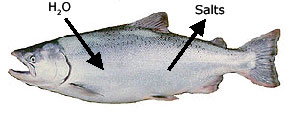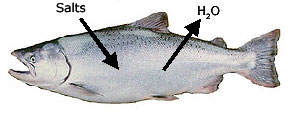Acclimation of Osmoregulatory Function in Salmon
Download a printable version of this essay.
As you know, salmon spend
most of their life in the open ocean, where they reach sexual maturity, but
lay their eggs gravel beds at the upper reaches of (freshwater) streams. When
the eggs hatch, the young salmon spend several months migrating downstream
to the ocean where they remain for some 3-5 years. When mature, the adult
salmon return to mouth of stream where they hatched (they remember the taste/smell
of the water in the stream), migrate upstream to its headwaters, spawn, and
die.
As you might expect, there
are some serious physiological challenges presented by habitats as different
as freshwater streams and the open ocean. The purpose of this essay is to
discuss one of those challenges — how to keep the concentration and composition
of their body fluids within homeostatic limits while migrating from fresh
to salt water and back again — that salmon must cope with during their
life cycle.
Osmoregulatory Problems for the Salmon
The information you need
to know in order to understand salmon osmoregulation is presented in the following
table.
Like nearly all vertebrates,
the salmon is an excellent osmoregulator. However, like virtually all osmoregulators,
the salmon is never in true equilibrium with its surroundings. As you can
see from Row #1 in the accompanying table, in the ocean, the salmon is bathed
in a fluid that is roughly three times as concentrated as its body fluids,
meaning that it will tend to lose water to its surroundings all of the time.
And, because the composition of its body fluids is so different from
the ocean water, the salmon will be faced with all manner of gradients that
are driving exchanges that will continuously tend to drive its body fluids'
concentration and composition beyond homeostatic limits. In particular, the
very high concentration of NaCl in the ocean water relative to its concentration
in the salmon's body fluids (see Row #2 in the above table) will result in
a constant diffusion of NaCl into the salmon's body. Unless dealt with
effectively, this NaCl influx could kill the salmon in a short time. In sum,
a salmon in the ocean is faced with the simultaneous problems of dehydration
(much like a terrestrial animal, such as yourself) and salt loading.
However, if fresh water, the
problem is basically reversed. Here, the salmon is bathed in a medium that
is nearly devoid of ions, especially NaCl, and much more dilute than its body
fluids. Therefore, the problems a salmon must deal with in fresh water environments
are salt loss and water loading.
|
Salmon
in Freshwater
|
Salmon
in Saltwater
|
|
|
[solutes]body >> [solutes]amb
|
[solutes]body < [solutes]amb
|
|
 |
 |
How Does The Salmon Solve Its Osmoregulatory Problems?
Fortunately, the salmon has some remarkable adaptations, both behavioral and physiological, that allow it to thrive in both fresh and salt water habitats. To offset the dehydrating effects of salt water, the salmon drinks copiously (several liters per day). You're probably thinking "It's a fish surrounded by water, so of course it drinks!", but in fresh water (where water loading is the problem) the salmon doesn't drink at all. The only water it consumes is that which necessarily goes down its gullet when it feeds. Of course, when an ocean-dwelling salmon drinks, it takes in a lot of NaCl, which exacerbates the salt-loading problem.
Kidney function also differs between the two habitats. In fresh water, the salmon's kidneys produce large volumes of dilute urine (to cope with all of the water that's diffusing into the salmon's body fluids), while in the ocean environment, the kidneys' urine production rates drop dramatically and the urine is as concentrated as the kidneys can make it. The result of this is that the salmon is using relatively little water to get rid of all of the excess ions it can (due to structural and functional limitations, the salmon's kidney cannot make its urine anywhere near as concentrated as humans can, but they do their best).
The final adaptation that we'll discuss is a remarkable one that salmon use to deal with the NaCl fluxes driven by the gradients between the salmon and its surroundings. In their gill epithelial cells, salmon have a special enzyme that hydrolyzes ATP and uses the released energy to actively transport both Na+ and Cl- against their concentration gradients. In the ocean, these Na+-Cl- ATPase molecules 'pump' Na+ and Cl- out of the salmon's blood into the salt water flowing over the gills, thereby causing NaCl to be lost to the water and offsetting the continuous influx of NaCl. In fresh water, these same Na+-Cl- ATPase molecules 'pump' Na+ and Cl- out of the water flowing over the gills and into the salmon's blood, thereby offsetting the continuous diffusion-driven loss of NaCl that the salmon is subject to in fresh water habitats with their vanishingly low NaCl concentrations.
Time course of the salmon's acclimation responses
The behavioral (drinking or not drinking) and physiological changes a salmon must make when moving from fresh water to salt water — and vice versa — are essential, but cannot be accomplished immediately. Thus, when a young salmon on its seaward journey first reaches the saline water at the mouth of its home stream, it remains there for a period of several days to weeks, gradually moving into saltier water as it acclimates. During this time, it begins drinking the water it's swimming in, its kidneys start producing a concentrated, low-volume urine, and the NaCl pumps in its gills literally reverse the direction that they move NaCl (so that they're now pumping NaCl out of the blood and into the surrounding water.
Likewise, when an adult salmon is ready to spawn and reaches the mouth of its home stream, it once again remains in the brackish ( = less concentrated than full-strength sea water) water zone of the stream's mouth until it is able to reverse the changes it made as a juvenile invading the ocean for the first time.